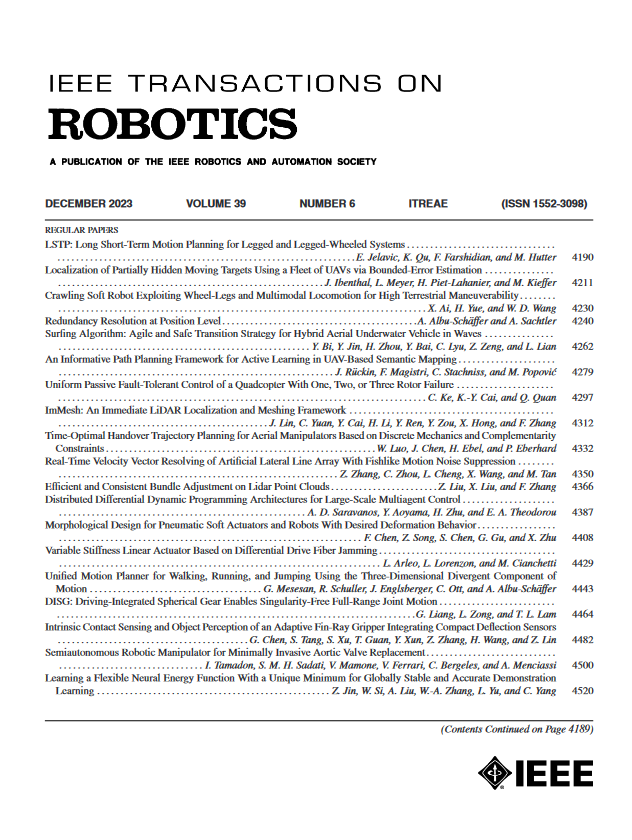FlowSight: Vision-Based Artificial Lateral Line Sensor for Water Flow Perception
IF 9.4
1区 计算机科学
Q1 ROBOTICS
引用次数: 0
Abstract
This article presents a novel vision-based artificial lateral line (ALL) sensor, FlowSight, enhancing the perception capabilities of underwater robots. Through an autonomous vision system, FlowSight allows for simultaneous sensing the speed and direction of local water flow without relying on external auxiliary equipment. Inspired by the lateral line neuromast of fish, a flexible bionic tentacle is designed to sense water flow. Deformation and motion characteristics of the tentacle are modeled and analyzed using bidirectional fluid-structure interaction (FSI) simulation. Upon contact with water flow, the tentacle converts water flow information into elastic deformation information, which is captured and processed into an image sequence by the autonomous vision system. Subsequently, a water flow perception method based on deep neural networks is proposed to estimate the flow speed and direction from the captured image sequence. The perception network is trained and tested using data collected from practical experiments conducted in a controllable swim tunnel. Finally, the FlowSight sensor is integrated into the bionic underwater robot RoboDact, and a closed-loop motion control experiment based on water flow perception is conducted. Experiments conducted in the swim tunnel and water pool demonstrate the feasibility and effectiveness of FlowSight sensor and the water flow perception method.FlowSight:基于视觉的水流感知人工侧线传感器
本文介绍了一种新型的基于视觉的人工侧线(ALL)传感器FlowSight,以增强水下机器人的感知能力。通过自主视觉系统,FlowSight可以同时感知当地水流的速度和方向,而无需依赖外部辅助设备。受鱼的侧线神经杆的启发,设计了一种灵活的仿生触手来感知水流。利用双向流固耦合(FSI)仿真技术对触手的变形和运动特性进行了建模和分析。触手与水流接触后,将水流信息转化为弹性变形信息,由自主视觉系统捕获并处理成图像序列。随后,提出了一种基于深度神经网络的水流感知方法,从捕获的图像序列中估计水流的速度和方向。感知网络的训练和测试使用从实际实验中收集的数据在一个可控的游泳隧道进行。最后,将FlowSight传感器集成到仿生水下机器人RoboDact中,进行了基于水流感知的闭环运动控制实验。在游泳隧道和水池中进行的实验验证了FlowSight传感器和水流感知方法的可行性和有效性。
本文章由计算机程序翻译,如有差异,请以英文原文为准。
求助全文
约1分钟内获得全文
求助全文
来源期刊

IEEE Transactions on Robotics
工程技术-机器人学
CiteScore
14.90
自引率
5.10%
发文量
259
审稿时长
6.0 months
期刊介绍:
The IEEE Transactions on Robotics (T-RO) is dedicated to publishing fundamental papers covering all facets of robotics, drawing on interdisciplinary approaches from computer science, control systems, electrical engineering, mathematics, mechanical engineering, and beyond. From industrial applications to service and personal assistants, surgical operations to space, underwater, and remote exploration, robots and intelligent machines play pivotal roles across various domains, including entertainment, safety, search and rescue, military applications, agriculture, and intelligent vehicles.
Special emphasis is placed on intelligent machines and systems designed for unstructured environments, where a significant portion of the environment remains unknown and beyond direct sensing or control.
 求助内容:
求助内容: 应助结果提醒方式:
应助结果提醒方式:


